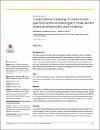Computational screening of known broad-spectrum antiviral small organic molecules for potential influenza HA stem inhibitors.
| Author | Mathew, Shilu |
| Author | Al Thani, Asmaa A |
| Author | Yassine, Hadi M |
| Available date | 2018-09-09T10:02:57Z |
| Publication Date | 2018-09-04 |
| Publication Name | PLoS ONE |
| Identifier | http://dx.doi.org/10.1371/journal.pone.0203148 |
| Citation | Mathew S, Al Thani AA, Yassine HM (2018) Computational screening of known broad-spectrum antiviral small organic molecules for potential influenza HA stem inhibitors. PLoS ONE 13(9): e0203148. https://doi.org/10.1371/journal.pone.0203148 |
| Abstract | With the emergence of new influenza virus strains that are resistant to current inhibitors such as oseltamivir (anti-neuraminidase (NA)) and amantadine (anti-M2 proton channel), influenza A viruses continue to be a serious threat to the public health worldwide. With this in view, there is a persistent need for the development of broader and more effective vaccines and therapeutics. Identification of broadly neutralizing antibodies (bNAbs) that recognize relatively invariant structures on influenza haemagglutinin (HA) stem has invigorated efforts to develop universal influenza vaccines. The current computational study is designed to identify potential flavonoid inhibitors that bind to the contact epitopes of HA stem that are targeted by broadly neutralizing antibodies (bNAb). In this study, we utilized the three-dimensional crystallographic structure of different HA subtypes (H1, H2, H5, H3, and H7) in complex with bNAb to screen for potential broadly reactive influenza inhibitors. We performed Quantitative Structure-Activity and Relationship (QSAR) for 100 natural compounds known for their antiviral activity and performed molecular docking using AutoDock 4.2 suite. Furthermore, we conducted virtual screening of 1413 bioassay hit compounds by using virtual lab bench CLC Drug Discovery. The results showed 18 lead flavonoids with strong binding abilities to bNAb epitopes of various HA subtypes. These 18 broadly reactive compounds exhibited significant interactions with an average of seven Hbonds, docking energy of -22.43 kcal·mol-1, and minimum interaction energy of -4.65 kcal·mol-1, with functional contact residues. Procyanidin depicted strong interactions with group 1 HAs, whereas both sorbitol and procyanidin exhibited significant interactions with group 2 HAs. Using in silico docking analysis, we identified 18 bioactive flavonoids with potential strong binding cababilities to influenza HA-stems of various subtypes, which are the target for bNAb. The virtual screened bioassay hit compounds depicted a high number of Hbonds but low interaction and docking values compared to antiviral flavonoids. Using structure-based design and nanotechnology-based approaches, identified molecules could be modified to generate next generation anti-influenza drugs. |
| Language | en |
| Publisher | Public Library of Science |
| Subject | Influenza Influenza A virus Crystal structure Influenza viruses Drug discovery H1N1 Antibodies Vaccines |
| Type | Article |
| Pagination | 1-24 |
| Issue Number | 9 |
| Volume Number | 13 |
| ESSN | 1932-6203 |
Files in this item
This item appears in the following Collection(s)
-
Biomedical Research Center Research [669 items ]
-
Biomedical Sciences [652 items ]


